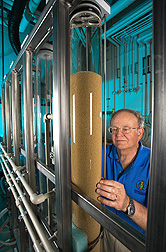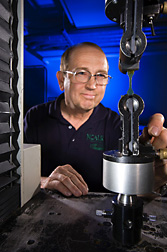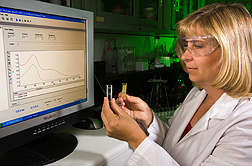Zein—A Corn Compound With Diverse Valuable Uses
Zein (pronounced “ZEE-in”), the chief protein in corn, has been commercially available for more than 60 years. In fact, until petroleum nudged it aside, zein was a chief ingredient for making adhesives, varnishes, binders, and films. Today, zein is mainly used in specialty coatings.
But now, thanks to renewed interest in biobased products stemming from rising crude oil prices, zein is getting a second look. At the ARS National Center for Agricultural Utilization Research (NCAUR) in Peoria, Illinois, for example, chemist David J. Sessa has developed new methods of physically and chemically modifying purified zein to create two polymer products: hydrogels and microspheres.
Cosmetic, Biomedical Uses—and Beyond
Sessa’s purification step overcomes a hurdle that’s slowed the corn protein’s wider commercial use—elimination of its yellowish color and distinct odor. His method of modifying the purified zein into either hydrogels or microspheres has set the stage for new potential uses in biomedicine. These include drug-delivery applications, drug capsules that dissolve in the body, and scaffolding for growing and shaping bone or other tissues.
|
|
Purified zein has food uses, too. In chewing gum, it could serve as an alternative to petroleum-based resins, which are slow to degrade, and natural ones, like chicle, which must be imported.
Finally, zein could also see action on the industrial front in the production of bioplastics, paper coatings, and packaging materials.
By drying zein-based hydrogel and compressing it, Sessa adds, “We’ve made films with good tensile strength and elasticity. Normally, protein-based films are brittle. But the films from these compressed hydrogels have excellent properties—and you don’t have to add plasticizers.”
What’s more, the films degrade into harmless byproducts—amino acids, the building blocks of protein.
Another trait that could bode well for zein’s biomedical future is its apparent resistance to bacterial growth. Sessa and colleagues tried to establish bacterial growth with zein using various growth media. But, he says, “We couldn’t even get any visible growth to count.”
Rethinking Zein Production
Different methods exist for extracting zein from feed streams containing whole corn kernels or corn gluten meal, a coproduct of ethanol production. These zein products are odorous and yellow.
Sessa sought to improve on methods that use activated carbons (AC). These porous, charcoal-like substances work by binding to, and trapping, the compounds that cause zein’s color and odor. The problem is that 37 percent to 95 percent of the zein is lost in the process. This, in turn, ratchets up production costs and restricts zein’s broader commercial use.
Sessa decided to examine the problem from the ground up. First, he isolated and identified the chemical structures of the compounds responsible for zein’s color—namely the xanthophylls lutein and zeaxanthin. “Those xanthophylls are imbedded in the zein helix structure, which makes them very difficult to remove,” he says.
Sessa then looked at what causes the off-odor. He isolated and identified the major contributor to be diferuloylputrescine, a compound from the bran fraction that tightly binds to protein.
Next, Sessa evaluated how well various AC products adsorbed the compounds from zein. This evaluation included monitoring the effects of temperature and AC pore size and depth. His consideration of AC alternatives eventually led to his use of zeolites, which are silicate- or clay-based particles whose pores act as molecular sieves in which zein’s color and odor compounds are trapped during purification.
Of about 150 native and synthetic zeolites, Sessa narrowed his search down to 2 synthetic types that best suited his needs: type “A” and type “X.” He was able to increase his zein yields by reducing the protein-component adsorptions to about 25 percent.
“I found zeolite 5A did a particularly good job,” he reports.
In keeping with his bottom-up approach to improving zein purification, Sessa also devised a novel method of using ultraviolet light spectroscopy to monitor zein deodorization during purification. And by collaborating with an engineer at a Salt Lake City, Utah-based company, Sessa’s ideas were used to construct column-based, pilot-scale equipment for purifying zein.
With the multicolumn system, an algorithm can be devised to selectively switch the flow of zein in aqueous ethanol through each of the columns. Normally, zein is pumped from the top down, but lab-scale studies Sessa conducted show it’s best to reverse the flow. “Otherwise, you get compaction of the column medium bed,” he says, which lessens the recovery of zein.
In March 2007, Sessa filed a patent (U.S. SN 11/728,700) on the system.
Sessa’s work and industry collaborations couldn’t have come at a better time, especially with the push towards biobased products and renewable fuels like ethanol. The 2007 ethanol production of 7.8 billion gallons produced 14.6 million metric tons of dried distiller’s grains (DDGs), now used in livestock feed, and about 8.2 million metric tons of corn gluten meal. The dry-milling operation represents 64 percent and the wet-milling operation is 36 percent of total ethanol production.
Traditionally, corn gluten meal, the more expensive byproduct, has been the chief source of zein. But, says Sessa, “The issue now is how to extract zein from DDGs. If you can accomplish that cheaply, then you open up all sorts of doors.”—By Jan Suszkiw, Agricultural Research Service Information Staff.
This research is part of Quality and Utilization of Agricultural Products, an ARS national program (#306) described on the World Wide Web at www.nps.ars.usda.gov.
David J. Sessa is in the USDA-ARS Plant Polymer Research Unit, National Center for Agricultural Utilization Research, 1815 N. University St., Peoria, IL 61604-3999; phone (309) 681-6351, fax (309) 681-6691.
"Zein—A Corn Compound With Diverse Valuable Uses" was published in the November/December 2008 issue of Agricultural Research magazine.









